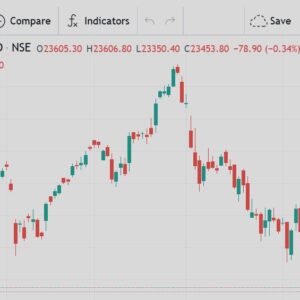Understanding the Nifty’s Consolidation at 23,000: Navigating Market Trends

Introduction
In the fast-paced world of finance, keeping up with market trends is essential for investors, traders, and analysts alike. One such trend that has caught the attention of many is the Nifty’s consolidation at the 23,000 mark. Understanding the factors driving this consolidation can provide valuable insights into market dynamics and help stakeholders make informed decisions.
What is the Nifty?
Before delving into the specifics of its consolidation at 23,000, let’s first understand what the Nifty is. The Nifty, formally known as the NSE Nifty 50 index, is the benchmark stock market index of the National Stock Exchange of India (NSE). It consists of the top 50 companies listed on the NSE, representing various sectors of the Indian economy.
The Significance of 23,000
The Nifty’s consolidation at the 23,000 level has garnered attention due to its significance as a psychological and technical milestone. When an index or stock consolidates at a particular level, it indicates a period of price stability or range-bound trading. In the case of the Nifty at 23,000, it suggests that market participants are assessing the current valuation and potential future direction of the index.
Factors Driving Consolidation
Economic Indicators
One of the primary factors influencing the Nifty’s consolidation at 23,000 is the macroeconomic environment. Economic indicators such as GDP growth, inflation, interest rates, and fiscal policies play a crucial role in shaping investor sentiment and market trends. A robust economy with strong fundamentals can provide support to the index, while concerns over economic slowdown or policy uncertainties may lead to consolidation or correction.
Corporate Earnings
Another key driver of market trends is corporate earnings. The performance of companies included in the Nifty index directly impacts its movement. Positive earnings reports and outlooks can fuel bullish sentiment and drive the index higher, while disappointing results may trigger consolidation or pullbacks.
Global Factors
In today’s interconnected world, global factors also exert influence on domestic markets. Events such as geopolitical tensions, trade disputes, and shifts in global monetary policy can create volatility and affect investor confidence. Therefore, monitoring global developments is essential for understanding the broader market context and anticipating potential risks or opportunities.
Technical Analysis
Technical analysis is a valuable tool for identifying patterns and trends in price movements. Traders often use technical indicators and chart patterns to assess market sentiment and make trading decisions. In the case of the Nifty’s consolidation at 23,000, technical analysts may look for support and resistance levels, trendlines, and other patterns to gauge the index’s future direction.
Implications for Investors
For investors, navigating market trends like the Nifty’s consolidation at 23,000 requires a balanced approach. While it’s essential to stay informed and analyze relevant factors, it’s equally important to avoid knee-jerk reactions based on short-term fluctuations. Long-term investment strategies based on thorough research and sound fundamentals can help mitigate risks and capitalize on opportunities in any market environment.
Conclusion
In conclusion, understanding the Nifty’s consolidation at 23,000 requires a multifaceted analysis of economic, corporate, global, and technical factors. By staying informed and adopting a strategic approach, investors can navigate market trends with confidence and adapt their strategies accordingly.









